Wellington X, LP 760 - Bank Head Farm, East Lothian, 20th April 1945
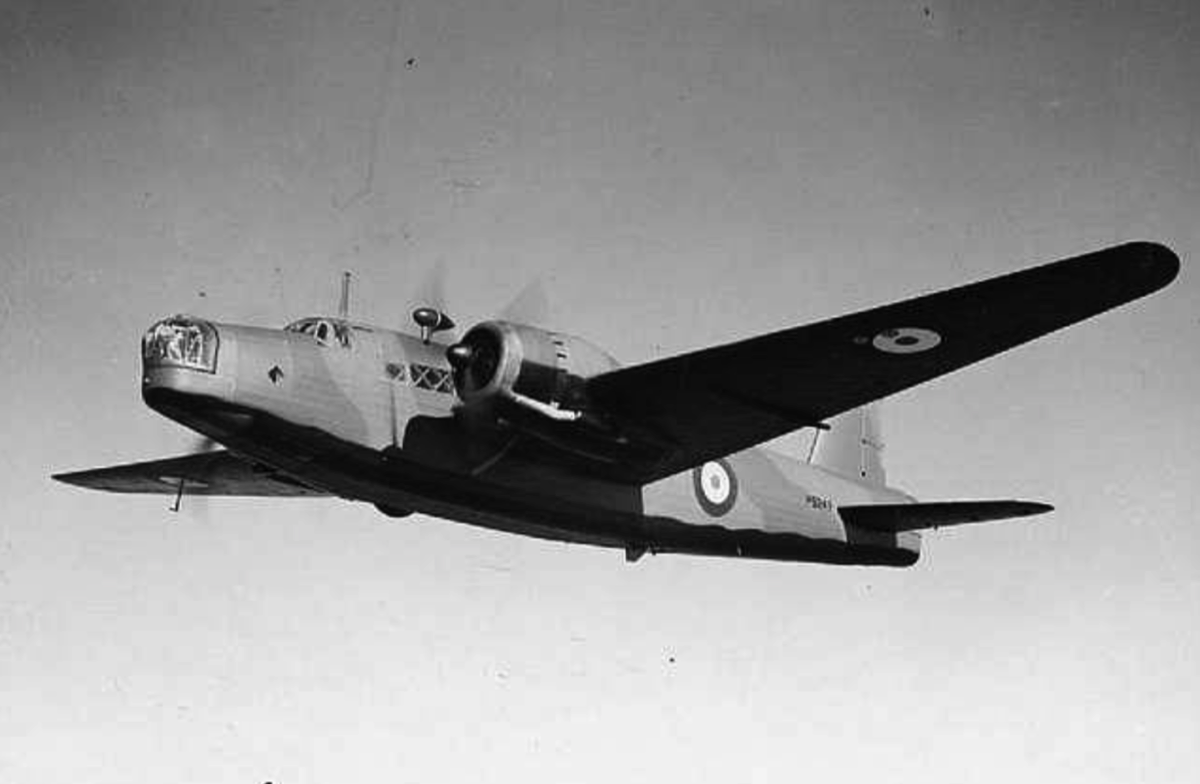
Photograph of Mark 1c Vickers Wellington,
In essentials similar to the aircraft lost in the crash on Bank Head Farm.
The crew
The loss of a bomber like the Wellington was rare in East Lothian. Royal Observer Corps member R. Trotter, Humbie ROC station, was a witness to the loss of Wellington LP 760 on the 20th April, 1945. He reported:
"I was on duty on 20th April and at 12.39 hrs I picked up the sound of a twin engined aircraft by sound and plotted it flying in a S.W. direction. I plotted it at Keith Marshal [sic: Keith Marischal House, near Humbie]. At 12 39.30 it turned N.W. and then in an easterly direction and I heard the sound of what seemed to be an unsynchronised roar from the engines. I saw it appear under the clouds at about 5,000 feet at 12.40 hrs still going east. It was not at a steep angle but gently coming out. There was a flash along the fuselage, a whiteish yellow colour, the aeroplane dropped and turned over. The starboard wing seemed to come away before it turned over and other bits came away, including a parachute which floated down further east."
What R. Trotter had witnessed was the loss of a Wellington Mk X, LP. 760, on a training flight from No. 19 Operational Training Unit, Kinloss. The intended route was from Kinloss to Fifeness, Gwylan Beach(Wales), Ramsay Bay (IOM), Eldridge Moss and back to Perth and Kinloss. Despite the hopeful sighting of a parachute, the crew of six, including its twenty-six year old English pilot, Flying Officer Aubrey Glyndwr Matthews, RAFVR, 153043, was lost.
F/O Matthews was an experienced pilot from London with 826 hours flying time, including just over sixty-four hours on instruments and in cloud. At twenty-six he was markedly older than his crew and, no doubt, had to take a bit of typical ribbing over that. Being older, he was also married, his wife, Eileen Matthews, joining those young women sadly widowed by the war. Aubrey Matthews was among those sent out to the sunnier open skies of Canada to train in March 1943, specifically to No.17 Empire Flying Training School in Nova Scotia (where he soloed after eight hours) and then to 13 Service Flying Training School where he continued his training on Harvards. He returned to the UK in November 1943 and joined the Central Navigation School, Shawbury, in May 1944 where he flew Wellingtons as a staff pilot until March 1945. In all, he amassed c416 hours flying Wellingtons and was rated as 'Proficient as a staff pilot'. He was then posted to No.19 O.T.U. in early April 1945 where he had flown nearly forty-six hours dual or as first or second pilot before the accident.
F/O Matthews, who was buried in Mortlake Cemetery beside the River Thames, led a young crew which was a typical wartime mix of nationalities. It included:
Sgt William Gourlay RAFVR, 1825511, aged 22, Air Gunner, from Glasgow. Buried in St Martin's Cemetery, Haddington, East Lothian.
Sgt Vivian Peter Dias RAFVR, 605691, aged 20, Bomb Aimer, from Georgetown, Demerara, British Guiana. Buried in Haddington's Roman Catholic cemetery.
Sgt John Daniel Pelham RAFVR, 1896217, aged 19, Wireless Operator/Air Gunner, from Dover. Buried in Dover St James' Cemetery.
F/O Edward Rawlinson RAFVR, 166236, aged 23, Navigator, from Horwich, near Bolton. Buried in Holy Trinity Church cemetery, Horwich.
F/O Robert Edward Williams RCAF, J/46275, aged 20, Navigator, from Niagara Falls, Ontario, Canada. Buried in St Martin's cemetery, Haddington.
"I was on duty on 20th April and at 12.39 hrs I picked up the sound of a twin engined aircraft by sound and plotted it flying in a S.W. direction. I plotted it at Keith Marshal [sic: Keith Marischal House, near Humbie]. At 12 39.30 it turned N.W. and then in an easterly direction and I heard the sound of what seemed to be an unsynchronised roar from the engines. I saw it appear under the clouds at about 5,000 feet at 12.40 hrs still going east. It was not at a steep angle but gently coming out. There was a flash along the fuselage, a whiteish yellow colour, the aeroplane dropped and turned over. The starboard wing seemed to come away before it turned over and other bits came away, including a parachute which floated down further east."
What R. Trotter had witnessed was the loss of a Wellington Mk X, LP. 760, on a training flight from No. 19 Operational Training Unit, Kinloss. The intended route was from Kinloss to Fifeness, Gwylan Beach(Wales), Ramsay Bay (IOM), Eldridge Moss and back to Perth and Kinloss. Despite the hopeful sighting of a parachute, the crew of six, including its twenty-six year old English pilot, Flying Officer Aubrey Glyndwr Matthews, RAFVR, 153043, was lost.
F/O Matthews was an experienced pilot from London with 826 hours flying time, including just over sixty-four hours on instruments and in cloud. At twenty-six he was markedly older than his crew and, no doubt, had to take a bit of typical ribbing over that. Being older, he was also married, his wife, Eileen Matthews, joining those young women sadly widowed by the war. Aubrey Matthews was among those sent out to the sunnier open skies of Canada to train in March 1943, specifically to No.17 Empire Flying Training School in Nova Scotia (where he soloed after eight hours) and then to 13 Service Flying Training School where he continued his training on Harvards. He returned to the UK in November 1943 and joined the Central Navigation School, Shawbury, in May 1944 where he flew Wellingtons as a staff pilot until March 1945. In all, he amassed c416 hours flying Wellingtons and was rated as 'Proficient as a staff pilot'. He was then posted to No.19 O.T.U. in early April 1945 where he had flown nearly forty-six hours dual or as first or second pilot before the accident.
F/O Matthews, who was buried in Mortlake Cemetery beside the River Thames, led a young crew which was a typical wartime mix of nationalities. It included:
Sgt William Gourlay RAFVR, 1825511, aged 22, Air Gunner, from Glasgow. Buried in St Martin's Cemetery, Haddington, East Lothian.
Sgt Vivian Peter Dias RAFVR, 605691, aged 20, Bomb Aimer, from Georgetown, Demerara, British Guiana. Buried in Haddington's Roman Catholic cemetery.
Sgt John Daniel Pelham RAFVR, 1896217, aged 19, Wireless Operator/Air Gunner, from Dover. Buried in Dover St James' Cemetery.
F/O Edward Rawlinson RAFVR, 166236, aged 23, Navigator, from Horwich, near Bolton. Buried in Holy Trinity Church cemetery, Horwich.
F/O Robert Edward Williams RCAF, J/46275, aged 20, Navigator, from Niagara Falls, Ontario, Canada. Buried in St Martin's cemetery, Haddington.
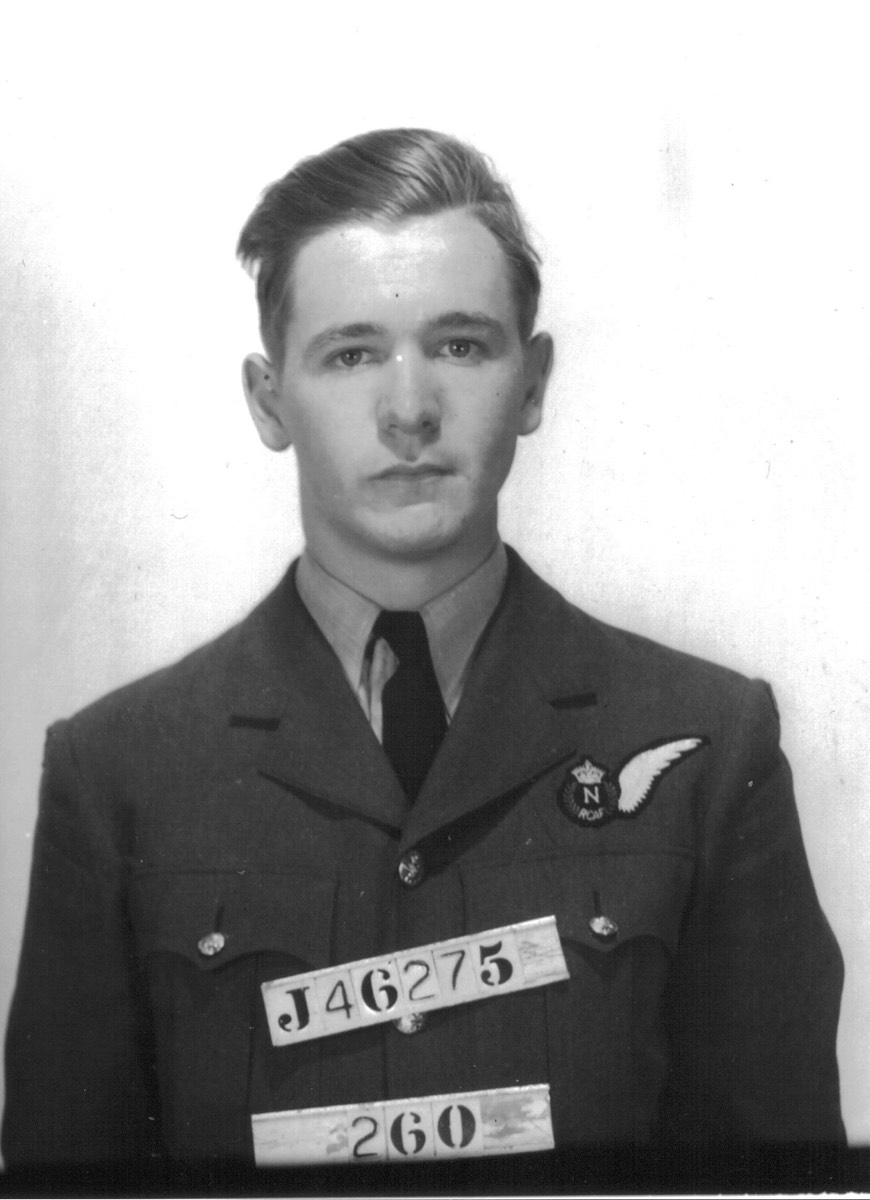
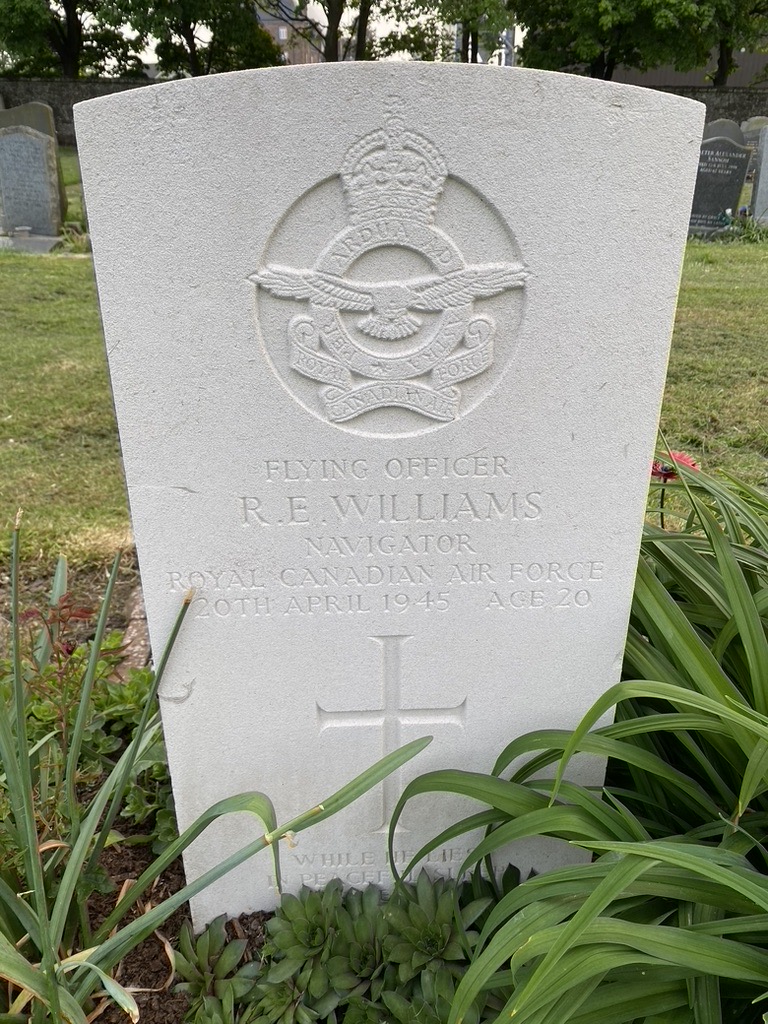
Flying Officer Robert Edward Williams, RCAF, Navigator
F/O Williams' gravestone in Haddington's St Martin's Cemetery
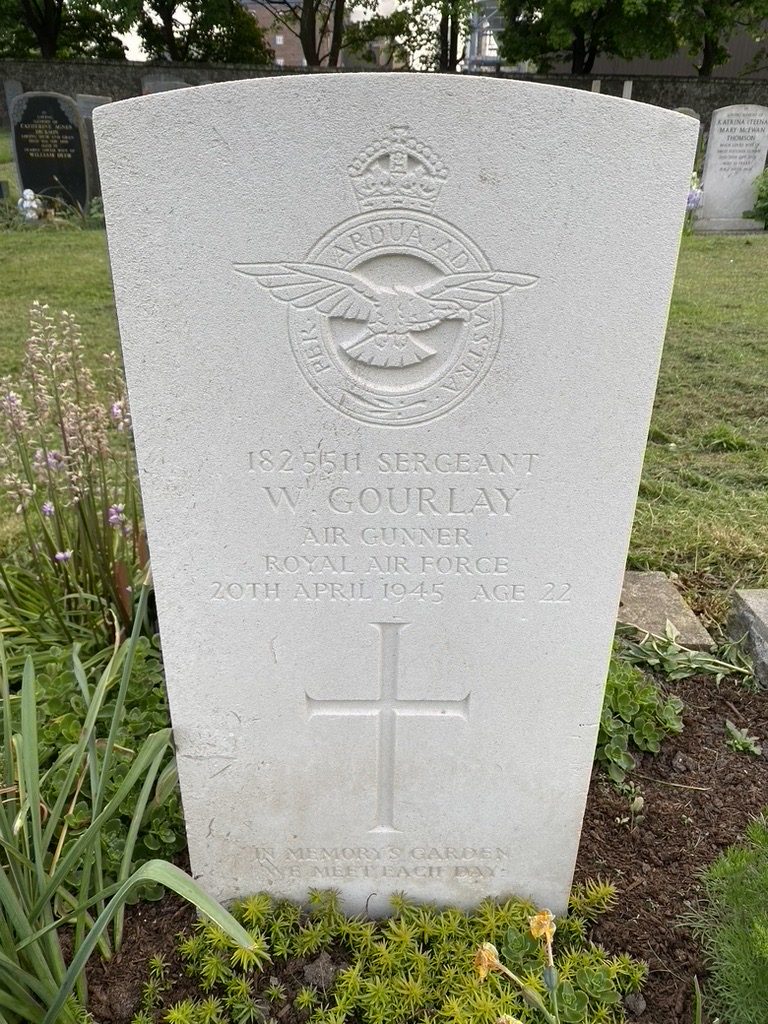
Sgt William Gourlay's headstone, Haddington
St Martin's cemetery
The aircraft
Wellington LP 760 had been manufactured by Vickers in Chester and was completed on the 6th of July 1944. Its engines had been built by Rover. At the time of the accident, the aircraft had flown 383 hours and 30 minutes and was due for a major inspection in sixteen hours time.
The accident
The crew took off from Kinloss at 11.52am and was advised, thanks to the prevailing cloudy and cold weather conditions, to climb to 15,000' over the airfield and to maintain that height throughout. The position of the aircraft indicated that Matthews didn't do this and may have encountered strong turbulence or icing as a result. For some reason, F/O Matthews wasn't strapped in at the time the aircraft reached East Lothian and he would have found it difficult to control the Wellington if it did indeed encounter icing or strong turbulence.
As mentioned by Robert Trotter above, the starboard wing broke free at the wing root, a rupture caused by the pilot's urgent attempts to recover from a spin to the right. The plane then effectively broke apart and fell to earth on Bank Head Farm fields, landing over a wide area of some 2,500 yards. The two engines buried themselves in the ground 100 yards away from the inverted parts of the main fuselage.
As mentioned by Robert Trotter above, the starboard wing broke free at the wing root, a rupture caused by the pilot's urgent attempts to recover from a spin to the right. The plane then effectively broke apart and fell to earth on Bank Head Farm fields, landing over a wide area of some 2,500 yards. The two engines buried themselves in the ground 100 yards away from the inverted parts of the main fuselage.
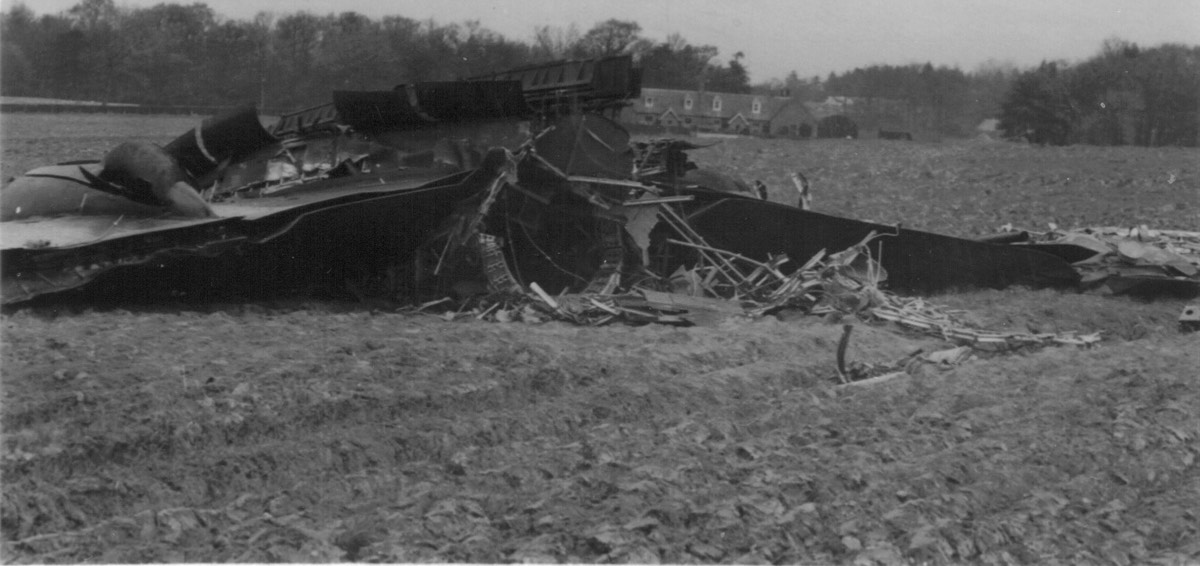
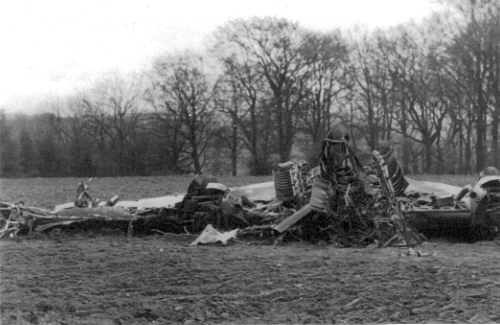
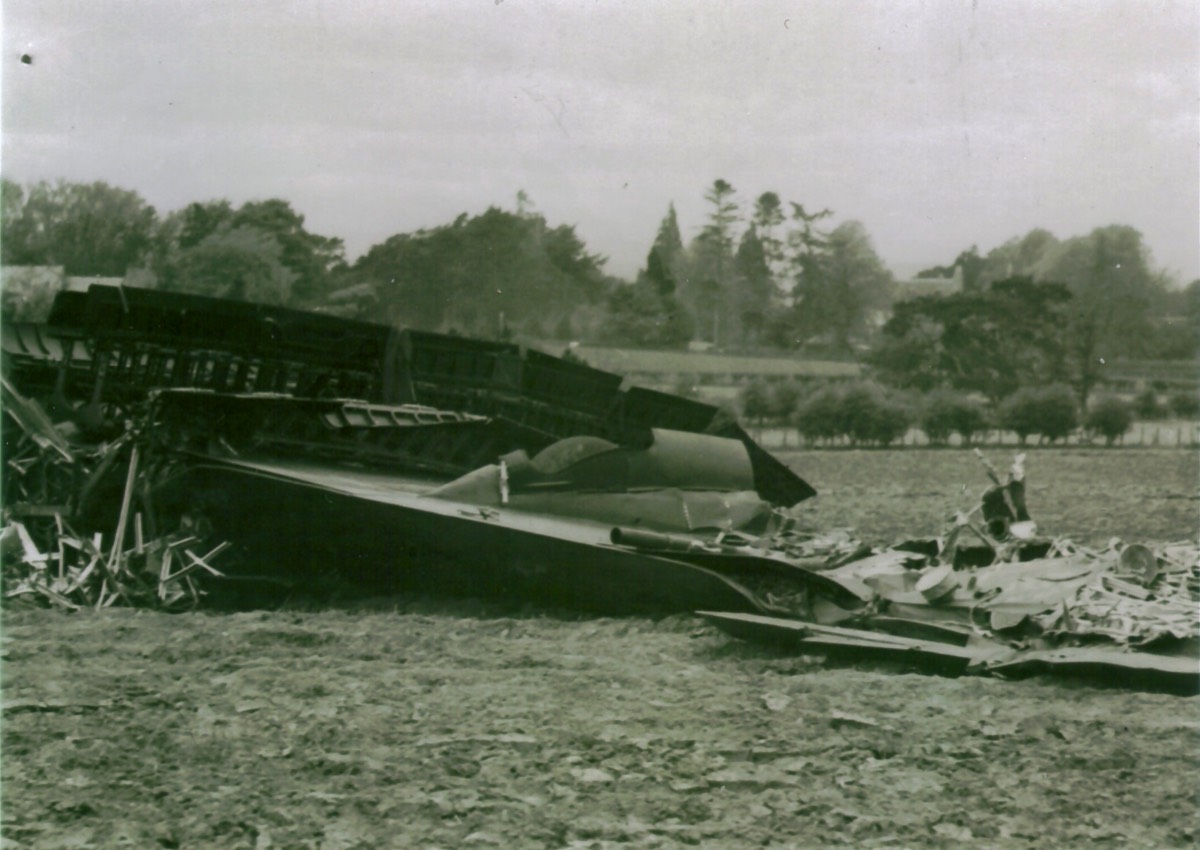
The above three photographs (source unknown) show the wreckage of Wellington LP760
at Bank Head Farm, near Humbie, East Lothian

